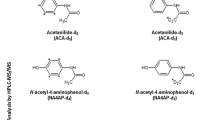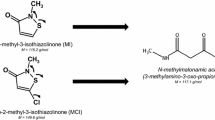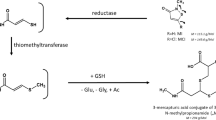Abstract
The main urinary metabolite of hydrogen cyanamide (syn.: cyanamide) in rat and man is acetylcyanamide (syn.: N-acetylcyanamide). An analytical method was developed to determine acetylcyanamide in the urine with a limit of quantification of <10 μg/l (mean recovery 96.1 % using spikes of 20 μg/l; relative standard deviation <4%). This methodology is based upon ion chromatography using column-switch techniques and UV detection. It could be demonstrated that in rats an average of 45.6% of oral applied cyanamide (10 mg/kg) was excreted in the urine as acetylcyanamide. In male human volunteers a mean of 40% of oral administered cyanamide (mean dose 0.25 mg/kg body weight) was excreted via the urine as acetylcyanamide. The same group of volunteers participated in a skin absorption study with dermal application of the above cyanamide dose onto a skin surface area of 32 cm2. Within an application period of 6 h an average cyanamide quantity of 2.3 mg was available for skin absorption. A mean portion of 7.7% of this quantity was found as acetylcyanamide in the urine of the participants. Findings from literature state that cyanamide is metabolized in vitro to cyanide. According to examinations performed in vivo, however, such a metabolic pathway seems to be irrelevant for man. In comparison with the control values there was no significant increase of both the cyanide concentrations in the blood and the thiocyanate concentrations in the urine of the above volunteers after the described oral cyanamide administration.
Access this article
We’re sorry, something doesn't seem to be working properly.
Please try refreshing the page. If that doesn't work, please contact support so we can address the problem.
Similar content being viewed by others
References
Anderson RA, Harland WA (1982) Fire deaths in the Glasgow area: III The role of hydrogen cyanide. Med Sci Law 22: 35–40
Deitrich RA, Troxell PA, Worth WS, Erwin VG (1976) Inhibition of aldehyde dehydrogenase in brain and liver by cyanamide. Biochem Pharmacol 25: 2733–2737
DeMaster EG, Shirota FN, Nagasawa HT (1988) Oxidation of cyanamide by a cumene hydroperoxide-supported catalase reaction yields cyanide and an inhibitor of aldehyde dehydrogenase. Biochem Arch 4: 203–207
Dunnett CW (1955) A multiple comparison procedure for comparing several treatments with a control. JASA 50: 1096–1121
McAuley F, Reive DS (1983) Rapid quantitation of cyanide in blood by gas chromatography. J Anal Toxicol 7: 213–215
Rheinwald U (1955) Über die biologische Bedeutung des Rhodans. Deutsche Zahnärztl Zeitung 10: 477–478
Rust U (1988) German Patent Application 38 27 449 of August 12, 1988
Shirota FN, Nagasawa HT, Kwon CH, DeMaster EG (1984) N-Acetyl-amide, the major urinary metabolite of cyanamide in rat, rabbit, dog, and man. Drug Metab Dispos 12: 337–344
Shirota FN, DeMaster EG, Nagasawa HT (1987a) Cyanide is a product of the catalase-mediated oxidation of the alcohol deterrent agent, cyanamide. Toxicol Lett 37: 7–12
Shirota FN, DeMaster EG, Kwon CH, Nagasawa HT (1987b) Metabolism of cyanamide to cyanide and an inhibitor of aldehyde dehydrogenase (ALDH) by rat liver microsomes. Alcohol Alcohol Suppl. 1: 219–223
Author information
Authors and Affiliations
Rights and permissions
About this article
Cite this article
Mertschenk, B., Bornemann, W., Filser, J.G. et al. Urinary excretion of acetylcyanamide in rat and human after oral and dermal application of hydrogen cyanamide (H2NCN). Arch Toxicol 65, 268–272 (1991). https://doi.org/10.1007/BF01968960
Received:
Accepted:
Issue Date:
DOI: https://doi.org/10.1007/BF01968960




